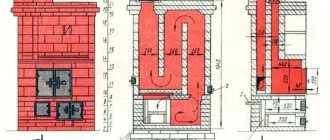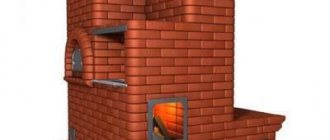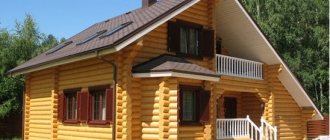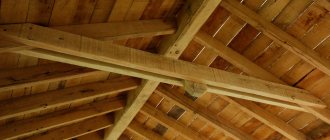- Brick
- Single chamber
- Cast iron
- Operating rules
If you have chosen stove heating for heating and want the temperature to be evenly distributed throughout the entire area, you have come to the right place. In this article we will tell you how to install a stove for a home with a water heating circuit of European quality at a price below the market average.
Peculiarities
Home owners still use heat exchangers. Their use is especially widespread in rural areas and new areas of cities, where there is still no gas supply. A conventional wood stove distributes heat unevenly. Using a water circuit allows you to distribute heat more evenly throughout your home.
Stove heating, supplemented with a water circuit system, is characterized by improved parameters and additional advantages:
- Ensuring long burning of fuel.
- Obtaining units of heat flow not only from smoldering wood, but also during the combustion of gases.
Types of wood stoves by material of manufacture
Wood-burning stoves, while still remaining an excellent source of heat, fit well into modern heating systems for private households. Wood-burning stoves can be divided according to the material of manufacture into the following main groups:
- brick (stone);
- cast iron;
- steel.
Brick wood stoves
Brick kilns are the most durable and expensive to build. A good stove is not cheap, and it is not easy to find an experienced installation technician. To build such a stove, fireclay and refractory red bricks are used, as when laying a wood-burning fireplace, special mastics for masonry, cast iron doors, grates, and valves for the chimney pipe. A brick oven takes a long time to heat up, but also retains heat in the room for a long time.
Cast iron wood stoves
Cast iron stoves are usually used as an additional heat source. Manufacturers create not only heat sources from cast iron, but also beautiful products that fit perfectly into the interior of any home. Heated cast iron retains heat excellently, and the presence of a hob allows you to cook food or heat water for domestic needs.
Metal wood stove
A metal wood stove can quickly raise a room's temperature using minimal fuel, but the thin steel they're made of doesn't allow the heat to last long. The simplest type of metal stove is the well-known “potbelly stove,” which is often used to heat small country houses or garages.
As mentioned above, the stove itself only heats the room in which it is located. In order to transfer heat to other rooms, there are two ways - organizing air heating with an air duct system, or water heating from a stove with a heat exchanger, piping and heating radiators. Air heating is easier to install, but has a number of disadvantages, which together outweigh the use of a traditional water heating circuit.
The disadvantages of air heating include:
- installation of air ducts through which warm air is distributed must be carried out at the stage of building a house, since they are quite bulky;
- the need to install fans with a flow rate regulator, which improve air circulation but produce noise. Installing a furnace with fans in the basement of the house can solve this problem.
- The need to install additional air filters to prevent dust transfer.
The advantage of air heating, which at the same time is also a disadvantage, is low inertia. That is, the rooms begin to warm up immediately after the stove is lit, but they also cool down quickly.
Another advantage of air heating is the absence of heating radiators. Air ducts, as a rule, are hidden under the ceiling of the building, and the space under the windows remains free.
In most cases, owners of houses with stove heating opt for a water heating circuit for a private home, so we will analyze this option in detail.
Advantages and disadvantages
The stove has become a necessary item in the Russian cold weather, but is often associated only as a heating method. However, stove heating with a water circuit can provide both heat and hot water.
Pros:
- high service life even under extreme conditions;
- the use of environmentally friendly materials for the firebox, which are freely available and at an affordable price;
- variety of designs;
- multifunctionality - makes it possible to heat the room, cook, reheat food;
- the similarity of appearance with a fireplace increases the level of comfort.
However, there are a number of disadvantages that await the owner during operation:
- long warm-up until heat transfer;
- you need to carefully look after the ash pan, chimney, draft;
- the greater the power, the larger the size of the heating device;
- increased fire hazard;
- the heat will be distributed only to those rooms that are in the immediate vicinity of the installation;
- most of the heat escapes through the pipe, which significantly reduces the efficiency indicator;
- you will have to lay firewood in a timely manner, clean the stove from waste and ash;
- to install the unit, you need to have certain knowledge;
- If the device is used incorrectly, it may cause carbon monoxide poisoning.
When people are not permanently in a residential complex, but come for the summer, it is recommended to use a frost-resistant substance for the stove that can withstand thawing and freezing without destroying the structure, in order to preserve its primary functions.
Features of stove-based heating
Stove heating is the norm for Russian villages, the reliability and practicality of which has been proven for centuries. And today, many village houses have ovens with a stove for cooking food and a hearth for baking bread.
Some of them are equipped with a water circuit for the heating system, while others are not. But rural homeowners are in no hurry to throw them away and replace them with modern boilers. A more trouble-free and problem-free heating method has not yet been invented.
Without a water circuit throughout the house, a wood stove can only heat a small space around it. For heating one or two rooms this option is acceptable, but for a large cottage it is no longer possible.
The following is burned as fuel in such village stoves:
- coal;
- peat;
- firewood;
- briquettes (eurowood).
There is no fundamental difference between these types of fuel from the point of view of the design of the stove inside and the wiring of the water heating system in a private house. Some of them give off more heat, while others take longer to burn out. But the design of the firebox and the layout of pipes with coolant in the rooms are the same in all cases.
When making a choice in favor of stove heating, do not forget about the fire safety standards for the construction of brick stoves - only their strict compliance will reduce the risk of fire to a minimum
Among the advantages of stove heating are:
- no dependence on the availability of electricity in the network;
- relatively low cost of installing a heating system;
- low cost of solid fuel and the possibility of using different types of fuel;
- extreme ease of operation;
- long-term heat transfer (for brick structures);
- versatility - suitable for heating and cooking food at the same time.
If a private house cannot be connected to main gas, then a wood stove will be the best choice for heating it.
The only exception is when coal or firewood is not available in a particular area. But this option in Russia is the exception rather than the norm.
The two main disadvantages of furnaces with a water circuit are the impossibility of automating operation and the difficulty of adjusting heat transfer in individual rooms
Also among the disadvantages of stove heating should be mentioned:
- long warm-up of the system before heat transfer begins;
- loss of useful space in the house due to the massiveness of the stove;
- heavy weight of the brick stove structure;
- low efficiency due to the loss of a significant amount of heat into the pipe;
- high fire hazard if used incorrectly.
A brick heating and cooking stove for a private house with water heating, depending on the design and number of rows, can weigh from 1.5 to 10 tons. Plus the weight of the pipe is added here.
A foundation for such a mass requires a powerful and expensive foundation, which can also be called a disadvantage of the heating systems under consideration.
Furnace design with a water circuit
Several implementation methods are classified:
- build with the initial inclusion of the correct size of the heat exchanger;
- install the register into a ready-made thermal unit.
The operating principle is simple:
- water flows into the circuit located in the fuel section;
- in the process of burning firewood or other types of fuel, the liquid is heated;
- then the boiling water enters the convective-radiation heating element, which distributes heat throughout the rooms;
- after cooling, the water returns to the coil.
Start of construction of water heating from the stove
Construction work is preceded by design work, which requires consultation with specialists. Stoves are usually located in the central areas of houses. The output of the fireboxes is kitchens or non-residential premises. In this case, the buildings are located in residential premises. This arrangement guarantees efficient heating of several rooms at once.
The dimensions of the stoves depend on the size of the houses themselves. It is important to take into account that a meter of oven area equals heating of about 35 square meters. m. According to this norm, its value is calculated in each specific case. In some cases, although rarely, registers are purchased for finished stoves. More often, a register is purchased first, and then the dimensions of the oven are determined for it.
Registers can be made of pipes or sheet material with a thickness of at least 3-5 mm. Thin ones quickly burn out, and therefore the unit needs to be replaced prematurely. They are installed in fuel compartments with a mandatory gap between them and the walls so that there is room to compensate for thermal expansion and efficient heat transfer. Access is also necessary for cleaning the firebox, which is important for efficiency.
Types of heating system diagrams for furnaces
This design must be equipped with taps for draining liquid. This must be done before the onset of cold weather, since frozen water can damage the device. An alternative is the initial use of antifreeze as a liquid substance.
Let us consider in detail each of the three types of structures.
Open
A classic design that operates on the principle of natural circulation, that is, due to the different densities of cold and hot water substances. Suitable for small buildings.
It is installed according to the traditional plan - an accelerating pipe with a height of more than 2.5 m and a diameter of 50 mm begins from the stove. An open type expansion tank is placed on top.
There should be a slope of 30 degrees from the upper outlet of the heat exchanger to the tank to avoid water hammer. The return outlet is placed in a horizontal position, then a drain is made to empty the heat exchanger.
In this case, the circumference must be more than 32 mm. The recommended material in the connection area to the furnace is only steel or copper.
Closed
It includes the mandatory installation of a pump for circulation and recirculation, a storage tank, a pressure gauge or thermomanometer, an automatic air vent and a safety valve.
In addition, there is a possibility of installing a heat exchanger, which significantly increases the overall efficiency, regulates the thermal regime, and accumulates heat during circular operation of the stove.
The piping is also supposed to be made of metal pipes.
Combined
Is the most preferred solution. Artificial heating of premises is carried out according to the rules of natural circulation of liquids. An auxiliary reserve supply is provided using a circulation pump. In cold weather, such a design will serve as a heater in the rooms of the house, and will allow you to cook food without the use of other energy consumers.
Organization of water heating in a private house from a wood-burning stove
A stove with a water circuit for heating a private house is the optimal solution for heating remote premises. It works as follows: in the furnace firebox, or in the chimney system through which heated gases escape, a metal heat exchanger is installed, which has an underwater and outlet pipe. Cold water is supplied to the underwater pipe, and heated water comes out of the outlet pipe.
Since cold water has a higher density than hot water, it displaces the heated water from the heat exchanger and pushes it through the pipes and up through the heating radiators throughout the house. The pipes are located with a slope of approximately 3-5 degrees from the furnace, thus allowing the coolant to flow freely. For the best circulation, a circulation pump is added to the system, which allows the liquid to constantly move in the pipes without stagnating or overheating.
Because the oven heats unevenly, the water can expand quickly. Excessive expansion can lead to explosion and destruction of pipelines. To compensate for expansion of the coolant, an expansion tank is also installed in the heating system.
Not only water can be used as a coolant, but it is the most versatile and cheapest means, although it has significant limitations in operation. The main one is the impossibility of using it in houses with non-year-round occupancy. If you do not heat the stove in winter, the water in the pipes will simply freeze and expand, damaging the pipes and heat exchanger. Therefore, the water is either drained before the onset of cold weather, or antifreeze is used.
When draining water, there is a problem of pipe corrosion due to air entering the closed system, so draining water also does not solve all problems.
The use of special antifreeze for heating systems can solve this problem, but the main disadvantage is the high cost of such compounds and the need for their periodic replacement.
One of the options for solving the problem of water freezing in the system is to insert a small backup electric boiler into the heating circuit, which will maintain the coolant temperature above 0 degrees, while consuming a minimum amount of electricity.
Almost any wood-burning stove can be equipped with a water circuit. There are three main options for arranging water heating in a private house from a wood-burning stove:
- using a factory-purchased furnace with an installed water circuit;
- construction of a brick kiln “from scratch” and installation of a water circuit into it;
- installation of a water circuit in an already built furnace.
Each of these options has its own advantages and disadvantages. Let's deal with each separately.
Installing a water circuit in an already built furnace
This is the most optimal and inexpensive option for houses where there is already a built stove, and the owners have decided to effectively use its heat to heat all rooms in the house. As a rule, in such cases the heat exchanger is mounted in the furnace firebox; sometimes this requires partial dismantling of the structures.
The simplest heat exchanger is a single-row or double-row coil welded from metal pipes. The best manufacturing material is stainless steel or copper, which are least susceptible to corrosion and burning and will last for many years, but these materials are much more expensive than their analogues and are rarely used.
Some craftsmen use ready-made cast iron radiators as heat exchangers, but their efficiency is lower, which makes this idea unjustified.
Most often, heat-resistant steel is used for such purposes, from which either tubular coils are made, which have a large heating area, or water jackets are made from sheet steel, which are easier to manufacture. The thickness of steel, as a rule, is selected within 3-5mm.
You can see various designs of such heat exchangers in the photo selection:
Construction of a brick kiln with a water circuit
Any new construction in our time is associated with large expenses, especially when it comes to stone stoves, because there are quite a few craftsmen who know their job well, and the prices for their services are very high.
However, stone stoves have many advantages:
- the service life of such furnaces can be several times longer than purchased metal versions;
- relatively high efficiency factor, reaching 70%;
- the ability to retain heat for a long time and heat the coolant, even when the wood in the firebox has burned out;
- The design of the stove itself becomes the center of attraction in the house and creates coziness.
Another advantage is the possibility of placing much larger heat exchangers than when reconstructing a furnace. In this case, it is possible to install a heat exchanger both in the firebox and in the chimney ducts to heat water from heated gases.
When the exchanger is located directly in the firebox, water heating occurs much faster, but at the same time condensation and soot will constantly form on the coil itself or the metal jacket. Also, in emergency situations there will be a danger of the heat exchanger boiling and exploding.
These problems can be avoided by placing the heat exchanger coil in the chimney ducts. Then heating will occur more slowly and more evenly. It should be taken into account that the surface area of such a heat exchanger must be at least twice the area of the structure located in the stoker.
As mentioned above, installing a stationary brick wood-burning stove is a complex task that only experienced stove makers can handle. If it is not possible to install such a stove, there are many options for industrial wood stoves that work successfully and have many advantages.
Furnaces with a water circuit for heating a factory-made private house
In the vast majority of cases, purchased steel or cast iron stoves will cost less than stone ones, and they can be installed independently. All elements of the furnaces are manufactured using high-tech equipment in the factory, so the quality of such heat generators is an order of magnitude higher than the artisanal options. In addition, such stoves have a manufacturer’s warranty, which is also an undeniable advantage.
Metal wood-burning stoves with a liquid circuit vary in design and can take the form of a fireplace insert or a solid fuel boiler with a fuel door with an inspection window and (or) a frying surface. There are many options, and the designers’ imagination is limitless.
The leaders in the wood stove market are such manufacturers as ABX, BLiST, Hergom, Klover, La Nordica, Termofor, Vesuvius, Laotherm, Ermak, Teplodar. Let's look at a few examples of products from these manufacturers and tell you about their characteristics.
Types of stoves
A stove with a water jacket (heat exchanger) provides long-lasting and uniform heating of water. This happens due to the fact that its walls cool down for a long time, continuing to heat the liquid. To create such a system, you can use ready-made small devices.
Brick
A heat generator of this type causes difficulties when laying. The structure consists of the following parts:
- metal plate;
- universal smoking and cooking chamber;
- ventilation duct;
- water heater boxes;
- oven.
Fireproof brick and mortar is used to create it.
Fireplace
They perfectly combine the purpose of a fashionable fireplace and a heating stove with a cooking circuit. They often use safety doors made of heat-resistant glass. They look good in the interior, while being quite reliable and not a fire hazard. The main advantage remains the high strength of cast iron, which allows it to easily withstand significant temperature changes.
Metal
Devices made of metal (cast iron and steel) belong to the category of permanent operation, that is, they need to be methodically “fed” to obtain heat transfer. At the same time, they heat up the room very quickly. Such a unit is presented in different price ranges, but its safety is much lower, since the walls heat up to maximum temperatures. A fire can occur even from slight contact with the surface.
Construction of an option for heating a greenhouse
To increase yield in the cold season, supplementary heating must be provided for the greenhouse. Unlike heating with electricity, using homemade heating boilers will be more financially profitable.
Rice. 3 Boiler for greenhouse
The best option would be to build a stove in the greenhouse with an exhaust chimney, which can be done with your own hands. Drawings for this can also be easily found on the World Wide Web.
The process of constructing equipment in a greenhouse consists of the following stages:
- It is necessary to lay a brick oven in the vestibule of the greenhouse.
- A chimney is installed along the entire length of the greenhouse at the top of the structure or under the beds.
- The exit for the pipe must be made on the other side of the greenhouse. Thus, carbon dioxide will escape, but the heat will remain inside the greenhouse.
Another option for a homemade boiler for a greenhouse is also possible:
- Selecting a large-volume barrel and painting it from the inside to avoid corrosion.
- Making holes in the barrel for the chimney, stove, additional barrel and cream tap.
- Installation of the firebox inside the barrel.
- Exhaust from the chimney barrel.
- Installing an additional expansion tank on the barrel.
- Welding heating for a greenhouse from a profile pipe.
- Layout of pipes inside the greenhouse structure.
- Purchasing a pump to circulate water in the greenhouse system.
A similar option for a greenhouse can operate both on wood and on other types of fuel. To control the temperature inside the greenhouse, homemade heating boilers can be equipped with an electronic temperature sensor, and the digital display itself can be placed directly in the house.
Autonomous heating in the form of homemade heating boilers is in demand both among owners of private houses and among residents of multi-storey buildings. This allows you to significantly save on the purchase of expensive equipment, as well as control the heating process itself. Homemade heating boilers can operate on wood, coal or other types of fuel, which allows the use of such units in various fields.
Russian-made pellet boilers
Fire tube boiler
Types of ovens by heating method
Stoves for water heating at home operate on wood, coal, peat, and eurowood. Depending on the type of camera, they differ in size and are divided into portable and stationary. In appearance, oven doors come with rectangular, slotted, round and shaft connectors. Furnaces may also have one or two operating compartments.
Single chamber
They are suitable for small spaces, quickly warm up the space, are affordable and do not require special knowledge to operate.
Double chamber
The lower and upper parts work on the principle of self-sufficiency. In the basement section, fuel burns, transforming into gas, which rises and combines with oxygen. This system allows you to save on fuel, while maintaining the maximum level of efficiency.
Convection
The functioning of the model is ensured by air circulation, so the cold flow coming from below is heated to high temperatures from above. Quick heating of the room, but also the same cooling.
Conditions for optimal system performance
The system will be operational provided there is constant circulation of coolant in the pipes. This is ensured by a mandatory slope, as well as the desirable installation of a circulation pump, which guarantees the necessary movement and prevents water from boiling.
Small in size, but with sufficient power, the pumps guarantee good circulation. They are necessary especially if the heating system is long. Installation of such a pump is carried out on the return line, that is, on the coolant return pipe.
You should not rely only on the pump and install pipelines without a slope, since interruptions in the supply of electricity may lead to boiling and failure of both the pump and the system itself. In such cases, it is better to resort to installing expansion tanks that compensate for the expansion of water.
Design work is completed by familiarizing specialists with the diagrams. They will help eliminate errors leading to unstable operation of water heating from the stove. This is also an opportunity to avoid security violations.
Copper
Such a coil is quite effective, because its thermal conductivity is considered very good. But it has one significant drawback - the melting point is 1083 °C. When using the unit in compliance with the established rules, you do not have to worry about rendering the device unusable. But in emergency and unforeseen circumstances, the heat can reach 1200°C. And the condensate that appears during cooling contains admixtures of dangerous chemical compounds that lead to the formation of corrosion. Therefore, installing this type of heat exchanger in brickwork is strictly prohibited.
Cast iron
They are very susceptible to rusting, have increased fragility, and thermal changes that occur during cooling and heating cause cracks to appear, which leads to failure of the heat exchanger. The cast iron register, due to insufficient processing of the metal, is constructed from cast parts, which reduces its reliability. Another disadvantage that can be noted is its heavy weight.
Steel
Heat exchangers made of such material are more common due to its availability, as well as the possibility of using any processing. According to the recommendations, the circuits are made of heat-resistant steel measuring from 3 to 5 mm, using pipes without seams.
Made of stainless steel
The cost of such a heat exchanger is at the level of previous options, but in terms of operational characteristics the device exceeds them.
They are ideal for baths, wooden houses and cottages, as they have special protection from high temperatures, which increases their service life.
Advantages and disadvantages of heating with wood
The high popularity of wood heating is due to the presence of a number of advantages of this fuel. Let's look at their advantages:
The most important and significant advantage of firewood is its availability. If you look at our country from space, you can see that its territory is completely covered with dense forests
Almost all areas of dense human settlement are located in places with an abundance of wood, while electricity networks and gas mains do not reach all populated areas. Their second undoubted advantage is their low price. When choosing a boiler to heat your home, for many of us, its cost is decisive. Therefore, even if electricity and gas are available, many people prefer to buy an inexpensive wood-burning boiler instead of a more expensive electric or gas one. The next advantage is ease of installation. A wood-burning boiler does not require expensive approvals and installation permits. Just buy, connect and use. Simplicity of design. As can be seen from the previous section, the boiler design is very simple. That is why many craftsmen independently make homemade solid fuel boilers with their own hands.
Photo 5: Installation and piping of a wood-burning water heating boiler at the dacha
We talked about the benefits of heating with wood. Now about the disadvantages. And they are very significant:
- The first thing I want to say is the high consumption of firewood. Since this fuel has a low calorie content, even to heat a small wooden house, you will need an impressive woodpile. What can we say about modern private houses and cottages with an area of several hundred square meters.
- The second is low efficiency. The design of such a device does not allow extracting maximum energy from the fuel, so part of it flies into the pipe. The efficiency of a wood-burning boiler with a water circuit is in the range of 70-80%.
- The wood in the boiler burns out quickly. To maintain a comfortable temperature in the premises, it is necessary to stand near the boiler day and night, constantly adding new portions of fuel to the firebox. Agree, this is not a very pleasant prospect, and you are unlikely to be able to automate the supply of firewood.
- The need for a room to install both the heating boiler itself and to store a huge supply of firewood. For safety reasons, the heating device must be placed in a boiler room built for it. The woodpile should also be installed nearby so that fuel is always within walking distance.
Here is a brief summary of the features of these devices. For more information about the operation of wood heating boilers, see the following video:
Choosing a furnace with a water jacket - recommendations
To choose a system that is suitable for your home, you need to consider the following parameters:
- for small structures with good insulation, a metal structure is quite suitable;
- In slightly larger buildings, consider the layout so that one installation can affect the entire building. To do this, you can try to design the heating using a water or steam circuit;
- for buildings with one floor, the circuit device is connected to both a brick and cast iron structure;
- in high-rise buildings (2, 3, 4), a cast iron stove-boiler is most suitable.
Lastly, you will have to decide on the type of fuel, since the type and final cost of the furnace equipment will depend on this.
Review and cost of popular models
Many trusted manufacturers offer their products, but Russian models are the most popular.
- "Eco-fireplace." The company offers the Bavaria Prismatic model - an economical device with an efficiency of 78%. The convenient dimensions of the firebox allow you to accommodate logs up to 50 cm. The heating power is 14 kW, which makes it possible to heat a room of about 100 square meters. m. The quality of the materials used guarantees uninterrupted operation of the fireplace for more than 10 years. The cost of the model is around 45 thousand rubles.
- The Czech fireplace Belt 10 Aqua from ABX is distinguished by its external aesthetics with a combination of metal and natural stone. Heated volume up to 220 cubic meters. m. The power of the fireplace is 10 kW. Both firewood and coal briquettes are used as fuel. Stoves in this line cost from 130 thousand rubles.
- Varta Aqua with stove and water circuit. It brings together a fireplace and cooking equipment, which is very convenient for use in small spaces. Model power 13 kW. Heated area up to 130 sq. m. Powered by wood and brown coal. The cost of such a universal fireplace starts from 35 thousand rubles.
- Angara Aqua. The fireplace is made of sheet iron. The interior of the firebox is lined with a heat-resistant substance. Power 13 kW, heated volume is 230 cubic meters. m. This allows you to heat a house up to 160 square meters. m. The device is equipped with prismatic panoramic glass. Works on pellets, dry wood and coal. Prices for Angara Aqua models start from 45 thousand rubles.
- EdilKamin Acquatondo 22 prism. Italian fireplace with excellent external and functional characteristics. Capable of producing hot water for home heating and technical water for domestic needs. Works on wood and coal briquettes. Power 23 kW. Wall or front installation. Prices for such equipment start from 200 thousand rubles.
Fireplace with water jacket Belt 10 Aqua from ABX
Among all the models presented, there will probably be one that best meets the stated requirements. Every year new and improved fireplaces are produced, by installing which you can create the necessary home coziness and comfort in your home.
Installation of stoves for a home with a water heating circuit - step-by-step instructions
In order to avoid the unpleasant consequences of improper assembly of the stove and heat exchanger, it is better to involve a specialist installer. He will take into account all the subtleties:
- Fire safety rules. It is necessary to protect the walls around the installation from fire with non-combustible materials.
- Assembling the chimney is the next step. Excellent configuration options can be purchased from the manufacturer Ferrum.
- A special gap of five millimeters, which is left when installing pipes, must be filled with a suitable heat-resistant sealant.
- Under no circumstances should the structure be walled up closely; it is necessary to leave a gap of 10/15 mm between it and the walls to compensate for thermal expansion.
- Afterwards, the equipment is checked and the heating device is installed (the heat exchanger must undergo a strength test with hydraulic or pneumatic pressure of six bar).
- In conclusion, the master connects all components of the structure and checks its readiness.
Operating rules
To ensure continued operation of the heating system, we recommend following the following procedure:
- Do not disconnect the radiator from the device during operation. Water expands when heated, and the increased pressure can cause an explosion.
- If the heat exchanger is already hot, do not allow cold liquid to enter the system, as the temperature difference leads to deformation and damage.
- Do not use an empty heat exchanger to avoid burnout.
- To increase productivity, a circulation pump should be used.
- Use antifreeze if necessary.
- Place the drain valve at the lowest point.
To extend the service life of the heat exchanger, it is recommended to select a unit with a higher power than you calculated according to the existing parameters. This will help reduce the stress that will occur if the furnace is forced to operate at its maximum capacity. This strategy will reduce wear on parts.
To ensure that the heating system functions smoothly, follow the operating instructions.
How to build a water stove at home
- There are three ways to do stove heating with a water circuit with your own hands:
- buy a steel stove from a manufacturer whose services include system installation;
- hire a craftsman - a specialist will select the material, make the device, lay out the stove and install the boiler;
- do it yourself.
How to make such a stove yourself
The principle of a boiler for water heating
Can you make such a system yourself? Quite, just experience in welding and bricklaying when building a furnace is enough. First you need to prepare the boiler (register, coil, heat exchanger).
You can buy such a device or make it yourself using sheet iron and pipes. Since the full process of manufacturing and installing a water circuit cannot be summarized in a short review, the main recommendations are presented below.
Manufacturing options and recommendations
Water heating from a wood-burning stove - diagram
For the boiler, a sheet of metal with a thickness of at least 5 mm is used, and its design is made in such a way that there is maximum heating of the water for further circulation. The boiler, welded from sheet steel, is easy to manufacture and operate – it is easy to clean.
But such a heat exchanger has a smaller heating area, unlike a pipe register. It is difficult to make a pipe register at home yourself - you need an accurate calculation and suitable working conditions; usually such boilers are made to order by specialists who themselves install the system on site.
The simplest method of a solid fuel heat exchanger is a regular potbelly stove with a built-in water system. Here you can take a thick pipe as a basis, then there will be much less welding work.
Attention! All welding seams must be made double, since the temperature in the firebox is not lower than 1000 degrees. If you weld ordinary seams, there is a chance that this place will quickly burn out
Complete the register drawings in accordance with the dimensions of the stove at home. The layout of the rooms of the house and the arrangement of furniture also need to be taken into account.
Here you need to pay attention that it is better to choose a scheme with sheet-metal boilers - they do not have pipe bends connected into one continuous circuit. It is not so troublesome to build such a structure
It is also convenient because after installation you can use the hob without any problems, which is not the case with some tube boilers.
Register made of smooth pipes - drawing
When the coolant moves by gravity, you need to raise the expansion tank higher and use larger diameter pipes. If the pipes are of insufficient size, then you cannot do without a pump, since there will not be good circulation.
Boilers equipped with pumps have their pros and cons: you can save money by installing pipes of a smaller diameter and not raising the system so high, but there is one significant disadvantage - when the electricity is turned off or the circulation pump burns out, the heated boiler may simply explode.
It is better to assemble the structure at home, on site, since the device, like individual parts, has a very large weight and dimensions.
System installation
Heat exchanger made of cast iron battery
- Before installation, a solid foundation is poured, on top of which it is better to lay a layer of brick.
- The grate can be laid at different stages: before the boiler, if there is a double structure, the lower part of which can be equal to or higher than the upper part of the grate, when the stove is low and the system is placed a little higher, then the grate, doors, corner on the stove are usually installed after installing the boiler .
- The housing is installed - usually it consists of two containers connected to each other by pipes.
- The entire heat exchange system is welded to the boiler: the exhaust pipe goes to the expander, goes in a circle, through the radiators, and on the other side the return pipe is welded to the boiler from below.
Stove heating with a water circuit allows, firstly, to use firewood much more rationally, and secondly, to evenly distribute warm air throughout the heated room.
If you decide to make your own heating system at home with a water circuit using wood, think through all the stages of the work, and if you have doubts about the successful outcome, it is better to contact specialists.
What are the differences?
Before buying and installing a stove in your home with a water circuit, we recommend that you familiarize yourself with the following design features of long-burning solid fuel systems:
- These fireplaces are distinguished by the presence and achievement of the maximum level of efficiency during use. To do this, the manufacturer uses the principle of pyrolysis or generation of gas masses. The temperature in the combustion chamber can reach about 180-220 degrees, while oxygen is supplied in a small, strictly limited amount. Thus, the logs begin to smolder very slowly, generating a large amount of heat. In this case, carbon dioxide is formed, which is also promptly processed in a compartment of the structure designated for these purposes;
- Heating stoves for long-burning homes have a large combustion chamber that can accommodate a large number of logs, which do not need to be chopped several times. The increased size of the hearth allows the heating device to operate from one load to ten hours continuously;
- Teplodar fireboxes and other fireplaces with a water circuit are additionally connected to the general heating system of the house, thereby being able to accumulate, accumulate heat, and distribute it evenly throughout all rooms and even across several floors of the cottage;
- Many models of stoves with a long-burning function, a water circuit, are equipped with a door made of tempered transparent glass, through which it is convenient to observe the combustion process in the flame.
The main components of a wood-burning hearth: the firebox is shown in section
Cast iron combustion chamber with round firebox without glass
It is interesting to know: this system functions and produces heating not only due to a water jacket, a long-term combustion system, but also convection (the walls of the device warm up and release heat from the given room, as well as those adjacent to it).
Principle of operation
In addition to the stove, the heating element of the system with a water circuit is a heat exchanger, which is built into the firebox or chimney. The water passing through the register is heated and then enters the pipes and radiators, releasing heat. Due to the temperature difference at the inlet and outlet of the heat exchanger, the liquid circulates in the circuit.
For optimal operation, a circular pump is built into the system, which allows the heated liquid to be more evenly distributed throughout the pipes.
The water circuit must be pressed out and air removed. When water heats up, it increases in volume and to prevent the system from exploding, it is necessary to provide an expansion barrel. When using a closed-type circuit, the reservoir can be located anywhere; in an open system, the expansion barrel is installed as high as possible.
To relieve pressure in the system, it must be equipped with an automatic air vent to release excess gases from the coolant and a safety valve. The devices can be combined into a security complex by including a pressure gauge.
Thus, if you include a long-burning wood-burning brick stove with a water circuit in your home heating system, you can significantly save on heating costs.
Important! The presence of a water circuit must be taken into account at the design stage of the heating system in the house.
Is it possible to install a heating register in an existing furnace?
It would be more correct, of course, to build the furnace around the manufactured register. But, if the stove is already standing, you can still build a water circuit into it. True, you will have to try hard - they are of considerable size and must somehow hold on. So the task is not an easy one. In addition, do not forget that you will have to make two more conclusions - to connect the supply and return pipelines.
The best option is to make a water jacket under the shape of the stove (this one is for a metal stove with burners)
Finding a place to locate the register is also not very easy. Its direct contact with fire is very undesirable, but it should be in an environment of hot gases. In this case, you can hope that the heat exchanger will last a long time.











